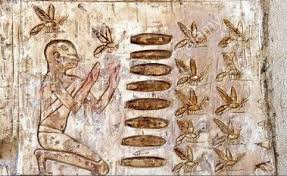ANCIENT HONEY
Ancient honey, particularly that found in Egyptian tombs, is remarkable for it’s longevity & edibility, even after thousands of years, due to its low water content, high sugar concentration, and natural antibacterial properties.
Here’s a more detailed look at ancient honey:
-
Longevity and Edibility:
- Archaeologists have discovered pots of honey in ancient Egyptian tombs, some dating back over 3,000 years, that are still remarkably intact and edible.
- This is due to the unique properties of honey, including its low water content and high sugar concentration, which inhibit bacterial growth.
- Honey also contains small amounts of hydrogen peroxide, which acts as a natural preservative.
- Archaeologists have discovered pots of honey in ancient Egyptian tombs, some dating back over 3,000 years, that are still remarkably intact and edible.
-
Ancient Egyptian Reverence:
- Ancient Egyptians revered honey and bees, believing honeybees were related to the Sun God Ra.
- They buried jars of honey in the tombs of royals, believing it would provide sustenance in the afterlife.
- Honey was also used in religious ceremonies and offered as sacrifices to gods.
- Ancient Egyptians revered honey and bees, believing honeybees were related to the Sun God Ra.
-
Scientific Explanation:
- The low water content of honey means it is inhospitable to bacteria and microorganisms.
- The high sugar content also creates an environment that is difficult for bacteria to grow in.
- The presence of hydrogen peroxide further protects honey from spoilage.
- The low water content of honey means it is inhospitable to bacteria and microorganisms.
-
Other Ancient Uses
- Honey has been used as a treatment for many ailments and conditions since ancient times.
- A drink containing honey and unfermented grape juice, known as oenomel, was used by ancient Greeks as a remedy for gout and nervous disorders.
- Honey has been used as a treatment for many ailments and conditions since ancient times.
-
Examples of Ancient Honey Discoveries
- In 1922, archaeologists discovered more than 2,000 jars of preserved honey from the tomb of King Tut, which was found to be sweet and edible.
- The oldest evidence of humans using honeybee products dates back to 7,000 B.C. in Anatolia, or Asia Minor.
- One Stone Age site in southeastern Turkey called Çayönü Tepesi, yielded exceptionally well-preserved beeswax residue from that time period.
- In 1922, archaeologists discovered more than 2,000 jars of preserved honey from the tomb of King Tut, which was found to be sweet and edible.






